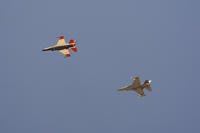
The Project for Government Oversight has distributed a press release that flags the number of mishaps the H-47 Chinook has suffered as a result of "brownout." Brownout refers to the pilot's loss of ground reference created by the cloud formed due to the helo's downwash. Generally, more downwash, bigger cloud. Here's the release:
Brownout Accidents Plague CSAR-X Helicopter:
Controversy Surrounds Air Force Selection
The H-47 Chinook clocked only 7 percent of all U.S. Army helicopter flight hours between February 2003 and June 2005, yet accounted for 30 percent of all brownout mishaps between fiscal years 2002 and 2005, data from the U.S. Army shows. According to Aerospace Daily and Defense Report yesterday, "Congressional lawmakers are reviewing downwash data for the helicopters that competed for the U.S. Air Force's combat, search and rescue (CSAR-X) helicopter replacement fleet to make sure rescue operations can be done safely." As part of this review, Congress should also look at Army data which show that the Chinook disproportionately suffers accidents from brownout (swirling dust and sand) compared to the rest of the helicopter fleet.
Boeing's H-47 Chinook helicopter was selected for the $10 to $15 billion combat, search, and rescue (CSAR-X) contract last year which required, but the contract is being re-bid in response to protests by competitors.
POGO recommends that the Air Force make a fair comparison of the bidder's proposals on the basis of this and all the other key performance parameters, and that the comparison and standards for comparison be made as transparent as possible to the bidders.
CSAR-X program documents clearly state the need for a helicopter which does not have a rotor downwash that will impede operations. According to the June 16, 2005, Capability Development Document for Combat Search and Rescue Replacement Vehicle (CSAR-X)/Personnel Recovery Vehicle (PRV):
The downwash produced by the CSAR-X (PRV), at mid-mission gross weight, in and around the recovery vehicle during a hover in all operational environments must not impede safe and successful recovery of isolated personnel. These environments include, but not limited to, heavily forested steep mountainous, smooth-level, rough-level, smooth-sloped, and roughsloped terrain in calm and high crosswind conditions. Loose particles such as tree limbs, sand, snow, water or rocks in the hover zone at mid-mission gross weights with SCL in Appendix G must not prevent the Recovery Team or injured and un-injured isolated personnel from conducting safe AIE operations (providing emergency life saving measures to isolated personnel, placement of a non-ambulatory personnel in a hoist recovery device, overland movement, self protection, communication, and swimming). (Emphasis added)
According to POGO Defense Investigator Nick Schwellenbach, however, "The Air Force seems to have ignored its own requirement when it picked the Chinook."
Despite the rotor downwash requirement, the initial competition picked a helicopterBoeing's Chinookthat produces significant downwash, and is prone to accidents due to brownout (swirling sand and dust caused by downwash). According to the May 2005 article "Brownout on the Battlefield," in FlightFax, a magazine by the U.S. Army Combat Readiness Center,
In the past 5 years, there have been 11 Class A, B, and C aviation accidents involving Chinook aircraft with brownouts being the trigger event. These mishaps have resulted in 16 non-fatal injuries and equipment damage costs in excess of $37 million.
A look at data compiled by the U.S. Army shows that the Chinook disproportionately suffers from brownout, and other mishaps and accidents when compared to the overall U.S. helicopter fleet.
-- Ward








